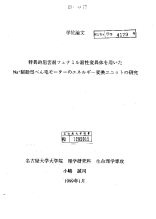特異的阻害剤フェミナル耐性変異体を用いたNa[+]駆動型べん毛モーターのエネルギー変換ユニットの研究 特異的 阻害剤 フェミナル 耐性 変異体 Na 駆動型 べん毛 モーター エネルギー 変換 ユニット
Access this Article
Search this Article
Author
Bibliographic Information
- Title
-
特異的阻害剤フェミナル耐性変異体を用いたNa[+]駆動型べん毛モーターのエネルギー変換ユニットの研究
- Other Title
-
特異的 阻害剤 フェミナル 耐性 変異体 Na 駆動型 べん毛 モーター エネルギー 変換 ユニット
- Author
-
小嶋誠司
- Author(Another name)
-
コジマ, セイジ
- University
-
名古屋大学
- Types of degree
-
博士 (理学)
- Grant ID
-
甲第4179号
- Degree year
-
1999-02-26
Note and Description
博士論文
Bacterial flagellar motor is the tiny and elaborate molecular machine which converts the electrochemical gradient of a specific ion (H^+ or Na^+) across the cytoplasmic membrane into the mechanical work. To understand the mechanism of force generation of the flagellar motor, it is essential to know how the coupling ion interacts with the force-generating unit of the motor. In this study, I investigated ion coupling sites of the Na^+ -driven motor by using the motility mutants resistant to a specific inhibitor, phenamil, whose interaction sites are thought to be located near Na^+ binding sites in force-generating units, and provided the first molecular evidence that phenamil directly interacts with the Na^+ channel components (PomA and PomB) of the motor. I isolated motility mutants resistant to phenamil from the marine bacterium Vibrio alginolyticus, whose polar flagella rotate by Na^+ - driven motors, and named the phenotype Mpa^r for motility resistant to phenamil. The motility of the wild type (Mpa^s) was inhibited by 50μM phenamil, whereas Mpa^r strains were still motile in the presence of 200μM phenamil. The Ki value for phenamil in the Mpa^r strain was estimated to be 5 times larger than that in the Mpa^s strain. However, the sensitivities to amiloride or bezamil, another amiloride analog, were not distinctly changed in the Mpa^r strain. The rotation rate of the wild-type Na^+ -driven motor fluctuates greatly in the presence of phenamil, which can be explained in terms of a relatively slow dissociation rate of phenamil from the motor. I therefore studied the stability of the rotation of the Mpa^r and Mpa^s motors by phenamil. The speed fluctuations of the Mpa^r motors were distinctly reduced relative to the Mpa^s motors. The steadier rotation of the Mpa^r motors can be explained by an increase in the phenamil dissociation rate from a sodium channel of the motor, which suggests that a phenamil-specific binding site of the motor is mutated in the Mpa^r strain. Based on these results, I expected that the Mpa^r mutations would be mapped in the genes encoding channel components of the Na^+ driven motor, such as pom (polar-flagellar motility) genes. I cloned and sequenced pom A and pomB from two Mpa^r strains, NMB205 and NMB201, and found a substitution in pom A (Asp148 to Tyr; NMB205) and in pom B (Pro16 to Ser; NMB201). Both residues are predicted to be near the cytoplasmic ends of the putative transmembrane segments. Mutational analyses at Pom A-Asp148 and PomB-Pro16 suggest that a certain structural change around these residues affects the sensitivity of the motor to phenamil. Co-expression of the PomA D148Y and PomB P16S proteins resulted in an Mpa^r phenotype which seemed to be less sensitive to phenamil than either of the single mutants, although motility was more severely impaired in the absence of inhibitors. These results support the idea that PomA and PomB interact with each other and suggest that multiple residues, including Asp148 of PomA and Pro16 of PomB, constitute a high-affinity phenamil-binding site at the inner face of the PomA/PomB channel complex.
名古屋大学博士学位論文 学位の種類:博士(理学) (課程) 学位授与年月日:平成11年2月26日
Table of Contents
- Abstract / p1 (0003.jp2)
- Contents / p3 (0005.jp2)
- Abbreviations / p4 (0006.jp2)
- Introduction / p1 (0007.jp2)
- Results / p6 (0018.jp2)
- I.Isolation and characterization of the Vibrio alginolyticus mutants resistant to phenamil,a specific inhibitor of the sodium-driven flagellar motor. / p6 (0018.jp2)
- II. Na⁺-driven flagellar motor resistant to phenamil,an amiloride analog,caused by mutations in putative channel components. / p10 (0029.jp2)
- Discussion / p16 (0044.jp2)
- Concluding remarks / p22 (0051.jp2)
- Materials and Methods / p23 (0052.jp2)
- Acknowledgements / p28 (0058.jp2)
- References / p29 (0059.jp2)
- Notes / p37 (0067.jp2)
- Putative Channel Components for the Fast-Rotating Sodium-Driven Flagellar Motor of a Marine Bacterium / p5104 (0087.jp2)
- Chemotactic responses to an attractant and a repellent by the polar and lateral flagellar systems of Vibrio alginolyticus / p2777 (0091.jp2)
- Characterization of polar-flagellar-length mutants in Vibrio alginolyticus / p1615 (0095.jp2)
- バクテリアのNa⁺駆動型モーターとべん毛運動 / p730 (0100.jp2)

